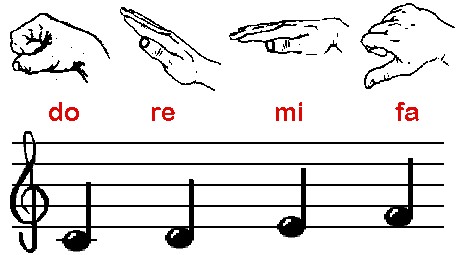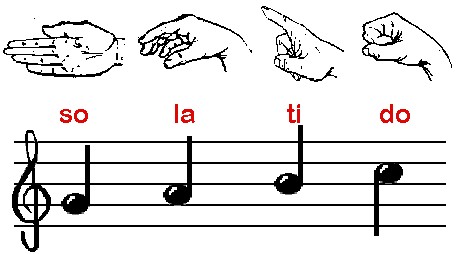A music teacher's thoughts on learning to play piano and to sing. Topics of interest include: intrinsic motivation, goal setting, practicing, technique, purchasing the proper instrument, performance anxiety, group v. individual instruction, song and piece repertoire, and assessment.
Saturday, July 16, 2011
Thoughts on Memorization
There is a group of piano players on Linkedin that has been discussing memorization. There thoughts are useful and valuable. I hope these ideas are helpful to you as well. See the following link to access: Memorization Tools
Tuesday, July 5, 2011
Solfege Pitches and Curwen Hand Signs
For singers, it is helpful to have a "cheat sheet" as a frame of reference for the Solfege scale. For kinesthetic learners, it is helpful to use the Curwen hand signs when singing solfege. ![]()
In Italy, beginning singers are taught to sing tunes entirely using solfege pitches which is quite remarkable.
When practicing sight-singing, it is helpful to give yourself (your student) a key center (Do) so that he or she can learn to find the other pitches surrounding do. In order to do this, you will need a helpful instrument such as a piano/ keyboard or pitch pipe. Garage Band (both '09 and '11) have virtual midi keyboards for use. Another suggestion is to download an application for your Iphone or Ipod that will give you a starting pitch.
(Ex: Virtuoso Piano free 3) from the Applications Apple Store
Preview of Kodaly websites: The following is an excerpt from the Solfege website (see link below)
Kodaly 101 - Classics for Kids - http://www.classicsforkids.com/teachers/training/Kodaly101.asp
Hand Signals - http://www.classicsforkids.com/teachers/training/handsigns.asp

 "
"
In Italy, beginning singers are taught to sing tunes entirely using solfege pitches which is quite remarkable.
When practicing sight-singing, it is helpful to give yourself (your student) a key center (Do) so that he or she can learn to find the other pitches surrounding do. In order to do this, you will need a helpful instrument such as a piano/ keyboard or pitch pipe. Garage Band (both '09 and '11) have virtual midi keyboards for use. Another suggestion is to download an application for your Iphone or Ipod that will give you a starting pitch.
(Ex: Virtuoso Piano free 3) from the Applications Apple Store
Preview of Kodaly websites: The following is an excerpt from the Solfege website (see link below)
"Singing and Solfege
Your students can learn about melodies and how to read music by using the one instrument we all have free access to - the voice! Kodaly, Mary Helen Richards, Education through Music, and other music methodologies utilize hand signals along with learning to sing and read music. Typically, music in Kodaly starts with the pentatonic (5-note) scale - do, re, mi, sol, la. If you play just the black keys on your piano, you'll hear a pentatonic scale. Below is an example of the hand signals used in a major scale. "Do" is movable meaning that the key or home base of a scale is always do - but do can be any note.
C Scale in Solfege
Subscribe to:
Comments (Atom)